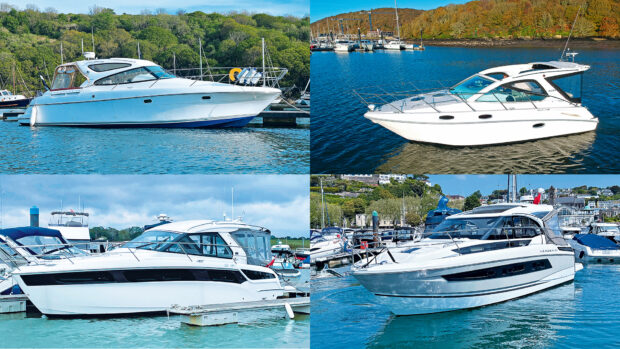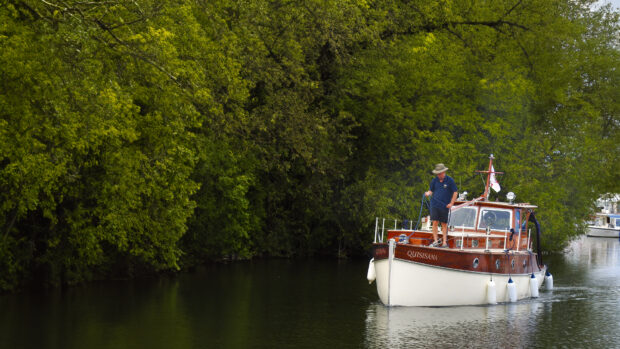The first motor boat from Italian yacht manufacturer Pardo Yachts is a real head turner and an absolute joy to drive
Only at a bun fight as bonkers as the Cannes Yachting Festival could you think of doing a sea trial on a high-performance sportsboat with more people on board than it has seats for. Sometimes it just happens like that.
The engines fire up and extra bodies materialise: a languid couple who were poking about down below elect to stay on for the ride; a hot prospect the local dealer has sent down from the stand to keep him away from a rival; a young salesman on his break who needs more sea time, along with the temp he’s been trying to chat up all weekend; and of course the boat’s designated skipper and crew.
So we were 12. The Pardo 43 is certified for that number under the RCD, so there were no safety concerns, but it was
pretty crowded, and of more import than where all these people were planning to perch and whether they had anything to hang on to, was their combined weight. But as Joey Ramone would have said, hey ho – let’s go.
Cantiere del Pardo wasn’t a name we knew until last September when the shipyard unveiled the 43, its first powerboat. But it’s
been in business for more than 40 years in Forli, on Italy’s Adriatic coast, and in that time has apparently built more than 4,000 sailing yachts under the Grand Soleil brand.
Design and engineering of the new 43 were undertaken in Bologna by powerboat specialists Zuccheri Yacht Design, and the boat is constructed using vinylester resin-infusion, foam sandwich laminates in the deck and topsides, plus carbon reinforcement. The T-top, which is fitted as standard, is also carbon fibre.
Although nominally available as either a one or two-cabin boat, there isn’t a lot of difference between the two versions. It depends on whether you want the centre section of the hull, beneath the cockpit, fitted out as a big, basic and probably very useful storage space, or – as on our test boat – as a sleeping area with a single berth each side of a central walkway which you can stand up in.

The berths are a good size – 6ft 3in by 33in (1.90m x 0.84m) with a reasonable 30in (0.76m) of sitting height over the mattresses. Up in the bow there is 6ft 3in (1.90m) of headroom at the bottom of the companionway, reducing to around 6ft (1.83m) at the foot of a big double bed.

Entirely open plan except for a head compartment on the starboard side which has a separate shower stall, the interior has small opening ports along the sides and a couple of glazed overhead panels in the lobby area. So although not big,
it’s fairly light, which is the next best thing. Ours was very nicely fitted out with white linings, stitched leather trim and a pale oak veneer, which is one of six wood finishes available. There are also nearly a dozen hull colours to choose from, 13 different fabrics for the exterior upholstery, and numerous shades of synthetic teak decking.

Up on deck, our test boat had the optional extended tender platform, which creates space for an aft sunbed with useful stowage beneath. Moveable backs on the cockpit seats are neat, elegant and practical.
Up in the bows, the superyacht- style anchor mechanism, concealed behind the stem, is a lot simpler and therefore – probably – more reliable than you might assume. There is excellent access under the foredeck hatch should you need it.

Three comfortable and secure helm seats face a well-organised instrument panel, with the compass, autopilot display and wheel in line, throttles and joystick an intuitive reach to the right, and a couple of drinks holders on the left. You can have the 370hp IPS500s if you like, but we had the 435hp IPS600s, which don’t take up any more room and offer valuable extra poke if, say, you find yourself with 12 people aboard.
That modish stem aside, the 43 sports a fairly conventional variable-vee hull, reducing from an incisive 50° deadrise right
forward to 16° at the transom.
As the Pardo poked its retroussé nose out into open water, it felt like it couldn’t wait to be let off the leash.
It’s not especially fast. No doubt we could have clocked up another couple of knots with fewer people on board, but if the extra weight caused any problems, Volvo’s automatic trim ironed them out. As we put the Pardo through its paces, trying and failing to establish the limits of its handling envelope, top speed felt less important than the sheer pleasure of driving a thoroughbred. Power, hull form and the interface between driver and machinery felt perfectly matched. Grip in tight turns was tenacious. Flat out, it inspired utter confidence. Head seas – mainly the quite steep and challenging wakes of larger boats – it hardly noticed, slicing through them with unruffled ease.
The Pardo 43 is an absolute joy to drive. If this is the shipyard’s first venture into powerboating, I’m very much looking forward to the next one. 
At a glance…
Length overall: 45ft 11in (14.00m)
Beam: 13ft 9in (4.20m)
Draught: 3ft 5in (1.05m)
Displacement: 9.9 tonnes empty
Fuel capacity: 264 gal (1,200l)
Water capacity: 66 gal (300l)
Engines: 2 x 435hp Volvo Penta IPS600
Price: From €469,000 (approx £495,107 inc VAT)

Fairline F-line 33-footer announced
Designed by Alberto Mancini, the Fairline F-Line 33ft open sportsboat will hit the water in early 2019, according to the

Hybrid heaven: Adler’s 76 Suprema
Taking diesel electric propulsion to a new level, Adler's 76 Suprema may just be too innovative for the yachting marketplace










